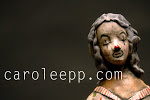
On Petra Bittl’s work One of mankind’s oldest cultural skills has experienced a renaissance in recent decades. Experimentation, the exploration of new innovative technical avenues and the interpretation of trends in contemporary sculpture and forms have raised ceramic art to a level that increasingly achieves recognition in today’s art world. Renowned national and international artists, painter or sculptors have accepted the challenge of unlocking the creative potential of fired earth and discover “ceramics”. Petra Bittl is one of these young artists who find their artistic expression in this genre.

Petra Bittl’s creative output has its origins in the intensive relationship between sketching, painting and clay. The aesthetic integration of sculpture and image transcend the pure form of the object. An alloy of form and content is forged within the ceramic sculpture itself, its porcelain epidermis a surrogate for canvas or paper. Drawings and pictorial elements define the sculptural form and detail both content and meaning with facet-rich autonomous stylistic idiom in each sculptural object. Petra Bittl’s sculptural approach defines itself primarily via the line as the essential element of form, graphic and structure. Lines structure her surfaces and animate forms and colours; they vibrate with the material’s own lively surface. They permeate and characterize the surface of the objects or guide the eye from the second into the third dimension as an extension of malleable design, thus encapsulating their environment. Ceramics as a medium gives the artist a wide-ranging freedom in determining the style of the lines, lines that are created by glaze painting techniques, sgraffito or the use of differently coloured clays – white porcelain on a base of almost pure black clay, as an example. Pure white finely textured porcelain stands in animated contrast to the coarsely grained coloured clays; the line determines the externality of the form, interrupting the harmony of the surfaces. Likewise, their fluid structure sets in motion the viewer’s perception, opening the object’s expressive potential.
The body of work represented by the porcelain tile defines the ceramic form as a primed surface and a medium for painting and sketching – a canvas or a sheet of paper. Tiles, familiar decorative and functional elements and infinitely reproducible in industrial processes, cast off their utilitarianism and are given an artistic meaning. They reveal abstract pictorial worlds that grapple with nature or with the decoration itself. Using a pate de verre technique (comparable to the monotype process), Petra Bittl creates layers of drawings and graphic elements on a gypsum block and then transfers them to porcelain. Unique works are created, because the process rules out reproduction. The properties of the ceramic material, however, again give the artist the freedom to combine it with plastic structures, additional objects or apertures.


The open hollow forms may at first glance appear ambivalent. Borrowing elements from the classic vessel form, they reveal themselves as fabric-robed human forms, striding or resting, singly or in pairs, dominating their environment. Here again, the use of lines, ligatures and constrictions structure the figures and express movement and tranquillity. The finely structured relief-like surfaces, however, give the ceramic material a new characteristic, not inherent in its natural state – a textile materiality and flowing softness. @font-face { font-family: “Verdana”; }@font-face { font-family: “Arial Unicode MS”; }p.MsoNormal, li.MsoNormal, div.MsoNormal { margin: 0cm 0cm 0.0001pt; font-size: 12pt; font-family: “Times New Roman”; }div.Section1 { page: Section1; }
@font-face { font-family: “Verdana”; }@font-face { font-family: “Arial Unicode MS”; }p.MsoNormal, li.MsoNormal, div.MsoNormal { margin: 0cm 0cm 0.0001pt; font-size: 12pt; font-family: “Times New Roman”; }div.Section1 { page: Section1; }
Petra Bittl’s artistic interest also manifests itself in a balancing act between ceramics’ stability and its fragility. Lines weave themselves with great sensitivity and conceptional calculation into shapes, endowing the solid clay medium with a powerful lightness. Strands and apertures filter the light and draw the viewer deep into the object. The contours of the surface become consciously tangible through the interplay of light and shade. The hard material appears soft and endearing. The artistic influence – as in all her work – is evident, be it the characteristic style of the formative hand or the revelation of principles of technical design.
Petra Bittl has consciously chosen an artistic direction in the sense of aesthetic material research in her work with ceramics and the process of crafts production. Her work does not draw its integrity and style from the development of new techniques, but rather from pushing the envelope of the ceramic material and its close relationship with drawing and painting. Translation: John Burland p.MsoNormal, li.MsoNormal, div.MsoNormal { margin: 0cm 0cm 0.0001pt; font-size: 12pt; font-family: “Times New Roman”; }div.Section1 { page: Section1; } www.petra-bittl.de







